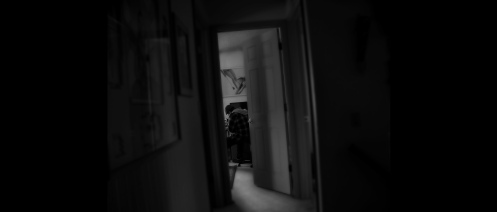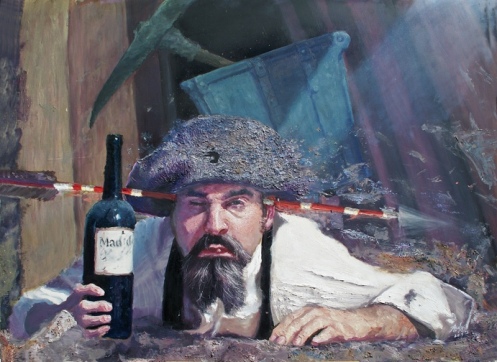
It’s not the easiest process for me to try and explain the art I create or how a person should approach this work. First off I probably will come across as a typical temperamental, self and all humanity hating stereotype artist, the likes of Hemingway, Pollock, Beethoven and Rothko. However what I create is only ever truly appreciated if observed as intended. For a time I compared the work I create to visual narrative poems. They tell a story after all but unlike a novel or a film, they are more metaphorical and require more participation of the viewer. These works are never finished until the viewer takes the time to think about them and find their own interpretation of the paintings context. Art is like life, there is no single meaning, it’s up to the viewer to find the meaning within themselves. Everyone’s meaning is personal. Truth is though, these are not paintings, as to call them such people will look at them the way they have been looking at paintings their whole lives and misunderstand this work. They are not films, novels or poems either. They are something in between.
I paint mostly in collections, and to understand the art the viewer has to see the collection, and some collections in a particular order. For example my collection “The Last Great Farce of Hope” revolved around the 19th century story of the American hopes and dreams to strike it rich in the gold mines out west, only to find most of the gold was already gone and life was much more cruel and brutal, especially for the Native American, Chinese and Mexican population. However this collection was an allegory for the acclimation of childhood innocence into the harsh reality of life and the world, in many cases the result of a traumatic event. The paintings within a collection often interact with one another. Think of them as a puzzle, a detail in one painting may answer a question within another.
I want people to look deep into the art. To stand and stare into the imagery, the brushstrokes, the pigment, like into an abyss, into a mystery. Take their time and enjoy the paintings. Contemplate the world, life, the society and culture they live in…themselves. These are images for inciting conversation, arousing questions and evoking the viewer’s imagination. They are both the comedy and tragedy of civilization. The work I paint is a funhouse mirror reflecting mankind back upon itself, for I simply observe the satire we live in and bend it into questions. Which is why I am not afraid to paint the profound flaws and complex attributes and emotions of the human condition. The art is greatly influenced by and layered with the psyche, social psychology, philosophy and the exploration of good and evil, as well as the struggle to understand the ever changing mores of society. Therefore the work is often considered dark and violent.
I’ve been told people do not like paintings of violence, rape and sexual desires, but if this is true then why do so many people engage in these acts? Why does violence and fornication seem to overwhelm society? Why are the highest rated newscast the ones focused on “breaking news” of horrible acts committed by humans on other humans? I don’t believe it’s the acts themselves that disgust us, but rather it’s that deep down we all secretly enjoy and take pleasure in these things. That is what really scares us. The mere fact we are still and always will be animals, beasts, despite how much we try to hide this actuality from ourselves. The truth is, it’s the self we despise the most.
Aside from igniting contemplation on what is wrong with ourselves, I paint the complicated and raw side of humanity and life, in hopes of reminding everyone of two things. First, there is no perfection, no utopia, and the good is always accompanied by the bad. And second, since we never know what tomorrow will bring, to appreciate the little things in life. The little moments such as being with friends and family, sitting back to enjoy a beautiful sunrise, gazing at the stars with a loved one. The moments people tend to take for granted and overlook as they search for material objects or exotic vacations, taking pictures with their phones of art, instead of actually enjoying the art before them, just to post their masquerade of an exciting life on social media to impress friends or become insta-famous.
For me, painting is not only about telling stories, both inspired by my own experiences and others, but about the expression of the story and emotion through the paint itself. I want people to look not only at the iconography but to feel the art by connecting to the brush strokes. Like Jimi Hendrix with his guitar or the voice of Maria Callas, the action of painting is a moment of passion captured in the studio. The thick aggressive strokes may provoke the anger or chaos within, as the softer touch of the brush whispers serenity and hope. As a painter it is important to me that people see and appreciate the style, the brushwork, and the artistry in the handling and movement of the brush and pigment.
The paintings need to challenge both myself and the viewer. I could paint appealing color combinations and symmetrical compositions to please the eye every time, but that would be too easy. I keep in mind the themes and ideas I wish to arouse with every collection and individual painting when working on them, so that they acquire their own character. Character births life, and these works must have life…a soul. They must live beyond mine or any person’s possession. They must become an eternal spirit, to which they may live their own lives long after I am gone, for generation after generation to come. Subsequently there is no my painting, for the art will exist with or without me.
I belong to the art.

















